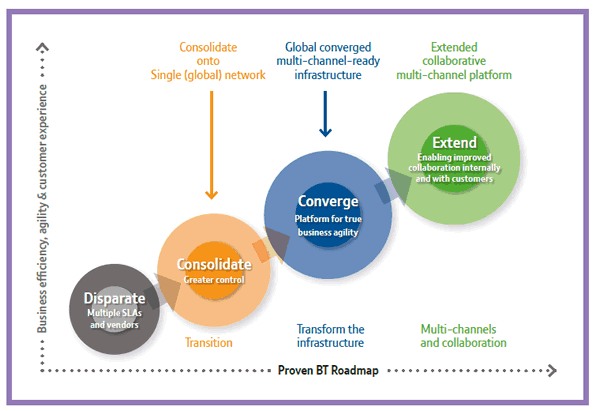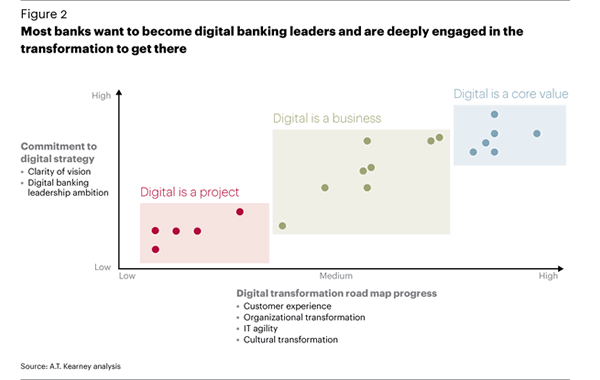 We often focus on optimization and digital transformation projects for the now in a rather ad hoc way. An example: if we want to change the ways we work in a more collaborative and agile way, very quickly the project involves the quest for a solution that enables this new way of working.
We often focus on optimization and digital transformation projects for the now in a rather ad hoc way. An example: if we want to change the ways we work in a more collaborative and agile way, very quickly the project involves the quest for a solution that enables this new way of working.
Assuming that there is a genuine mind shift, without which there is no transformation, this could, for instance, result in a unified collaborations and communications (UC&C) project with specific technological solutions.
Making abstraction of all the – key – human and process-related aspects, the choice for solutions in multiple ‘mobile and agile’ working projects is often defined by the current needs and pain points. However, there is also a tomorrow and a long time after tomorrow. While a specific solution might cover today’s needs it may not tackle the needs and challenges of tomorrow. That’s why it’s crucial to have goals in mind that stretch over a longer period. And this is where a digital transformation strategy and roadmap come in when looking at your digital transformation project today while taking into account your tomorrow. It’s also why we urge organizations to have a, what we call, ubiquitous optimization approach.
Moving beyond current and historical realities
The mentioned ad hoc approach focusing on the now also stems from practical, priority-related and historical realities.
Some examples:
- The origin of the request. The demand to transform (part of) the way organizations work can come from the CEO in broader context of enterprise-wide transformation to tackle multiple challenges and redesigning the enterprise. But it could also be part of an HR-triggered BYOD and agile working project to retain and attract talent. Or maybe it’s part of a customer experience optimization project focusing on a more outside-in approach in a specific department such as a contact center or even a cost savings and efficiency improvement pain point in such a department. If, in the latter cases, the organization doesn’t look at the overall picture and the future, the project can lead to choices that solve actual pain points but aren’t scaled and can’t be taken to the next level once the organization needs to and realizes the technological choices are limited to the now.
- The building blocks of the past. Legacy systems and silos might be taken for granted (and in some case there is little choice) or simply overlooked. This way you can end up with a project that is built upon premises and conditions that might change faster than expected. As such this isn’t a disaster: the now matters. But if you don’t have the future goals in mind as they become visible today and will change tomorrow, you can again end up in a situation where the solutions are too restrictive. In your roadmap for the future, legacy systems and siloed responsibilities over various agile working dimensions in our example (the people in charge of telephony, those in charge of the network, the workplace, etc.) will need to be questioned, even if in the current situation some can’t be tackled today.
In our example of new ways of working and UC&C there are several roadmaps such as the one below by our partner BT Global Services (described here). Even if it’s about solutions, it’s clear that in each step there can be different pain points but that at the same time the end goal in this case goes hand in hand with genuine transformation. When doing this exercise for your transformation project look at the process-related and human dimension too, combined with your goals, metrics and broader ecosystem.
Note that a pain point, which is translated into a case for business transformation, and a roadmap as such are not enough. You also need a strategy that encompasses all elements. But you also need to just do it and learn as you go. Don’t over-strategize and keep lean design and development principles in mind.

The end goal of a digital transformation project – always dynamic
There is no end goal in digital transformation. There is only a temporary end goal as everything is very dynamic and goals change and evolve.
However, it’s important to keep that “temporary end goal” in mind (and clearly describe it) in your roadmap for the future when looking at the transformation goals you need to achieve today because of specific pain points and challenges. Obviously, there will be differences depending on your industry, ecosystem, customers, goals and, more importantly, individual organization. A nice example on a vertical industry level can be found in an excellent article on the digital transformation roadmap for banking, showing multiple realities and steps to take into account by A.T. Kearney. Check it out. Again: your individual roadmap will of course look at your context and that of your ecosystem and goals, and it’s not a strategy as such. There are several steps and blanks to fill in.

More about digital transformation and (retail) banking here.
Knowing what the current end goals are and having a responsive and pro-sponsive culture whereby the dynamic nature and unknown dimension of the future is looked at by staying close to your customers, workers, market evolutions and so on is essential to make today’s investments work.
Again, this all makes abstraction of the personal, cultural, process-related and human aspects. You will have to answer many other questions in our example such as the mind shifts that are required, the changing skillsets and what makes people collaborate and want them to work differently to start with.
But it’s key to know what the ideal future will look like or at least be aware of that rapidly changing future when conducting a digital transformation project today.
Images purchased under license from Shutterstock

